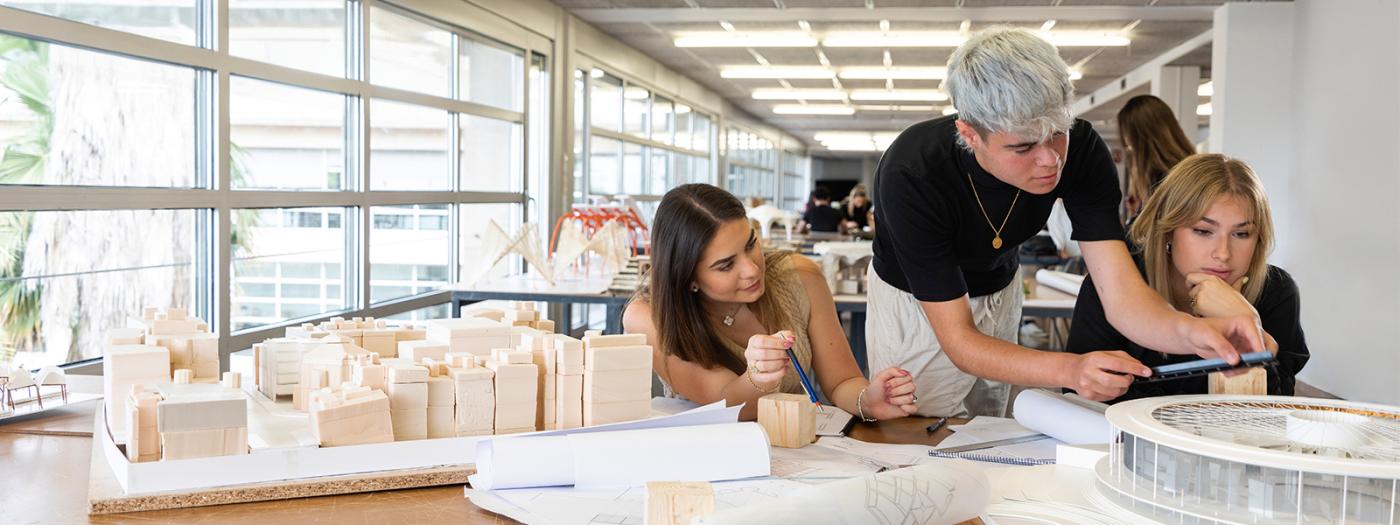Titular Professors
Professors
It is required that the student has drawing skills to express his/her ideas and to explain them graphically.
Learning Outcomes of this subject are:
Generals
RA.05 Ability to understand the relationships between people and buildings and between buildings and their surroundings, as well as the need to relate buildings and spaces located between them according to human needs and scale.
RA.09 Adequate knowledge of physical problems and different technologies, as well as the function of buildings, to provide internal conditions of comfort and protection of climatic factors.
Specifics
RA1 Analyze the architectural design project in relation to its geographical, historical, social context, recognizing the value of the qualities of the place
RA2 Develop the architectural design at a technical, constructive, structural, climatic level...
RA3 Represent the architectural design project following the established graphic criteria and publicly present the synthesis of the design.
It is a practical subject based on the student's work, which is developed in a Design Studio-workshop environment, through analysis and proposal exercises. In their development, students begin to understand that the design project is a transformation of an existing situation, in which the conditions are both a starting point to respect and to promote; and therefore topography, climate, environmental issues of the site will influence the final shape of the intervention, to accommodate the needs of the project and the given conditions.
The statements are concrete, bounded and successively emphasizing a specific aspect of architecture such as:
_the base/ground, with topography transformation exercises
_the structure/support, with exercises that expose the student to its role and functioning, the material to use and its expressive capacity
_protection/roof, with exercises on given guidelines in which to undertake an enclosure.
By focusing on one of these topics, the student concentrates on the problem to state and solve, while other aspects arise that delve into the complexity of the project. Small programs are progressively introduced, to finally face a complete project in which relevant issues arise and enrich the debate.
Public revisions of the work, as well as explanations, lectures and visits allow the student to find references to deep on any design project solution.
The subject is a design studio in which students work and revise their proposals in the classroom: it is mainly practical.
It has a learning by doing methodology, applied in the analysis as well as in the design exercises. Therefore, Personal implication is the main key to learn.
Students gather in groups of a maximum of twenty people, each of them conducted by a teacher. Given an exercise, a debate is conducted about similar situations and questions arise about that help to identify the purpose to achieve and guide the work. Once the student has started to work, the teacher debates the proposal, recommends, and backs the student in his/her development of the project.
The exercises are concrete and very limited, emphasizing a specific architectural item: such as the base/land, the structure/support, and the protection/ cover. By the end of the course, the students will have faced a great variety of aspects that the project addresses.
On the days indicated as submission, the exercise must be uploaded to the eStudy before deadline and in PDF format.
Attendance to classes is mandatory, missing more than the 20% of them, even if justified, leads to a not presented grade.
Dedication
Subject dedication 5 ECTS * 25 hours/credit = 125 hours
Semestral dedication 14 weeks (12 classes + 2 evaluation)
Weekly dedication 9 hours/week
Total dedication:
-Lectures 2 hours
-Workshop 48 hours
-Homework 70,5 hours
-Juries 4,5 hours
For the evaluation of the student work, the teachers will take into account the ability or the student to respond to the given problem to solve it, the reflection on the data, the ability to conduct the work and the ability to develop it. Personal implication and design presentation are also relevant.
The student skills and knowledge are evaluated through the following work and submissions:
-Highly significant evaluation activities:
*Projects
*Presentations
*Jury
-Moderately significant evaluation activities:
*Home and school work as well as individual and team work
*Continuous assessment
*Corrections
The teachers will take into account the ability or the student to respond to the given problem to solve it, the reflection on the data, the ability to organize, conduct, develop the work and represent it. Assistance to classes is fundamental to follow the course.
Criteria for the evaluation of the exercises:
ANALYSIS AND APPROACH (20%): environment, objectives, and approach
PROJECT DEVELOPMENT (40%): concept evolution, program adaptation, materialization/structure/construction
PRESENTATION (30%): graphic presentation, models5IMPLICATION (10%): explanation, participation, attendance
Blake, P. `Maestros de la Arquitectura Moderna´
Gídeon, S. `Space, Time and Architecture´
Gombrich, E. `History of Art´
Zevi,B. `Saber ver la arquitectura´
Siza, A. `Conversaciones con Valdemar´
Summerson,J. `The Classical Language of Achitecture´
Koolhaas,R. `Elements of Architecture´
Alexander,C. ` Pattern Language´
